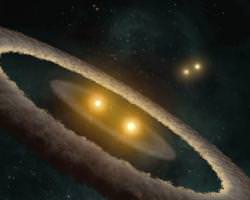Here in the Solar System, we’ve only got one star: the Sun. That gives us nice predictable daily and annual cycles; night and day, the seasons, that sort of thing. Astronomers have found a newly forming extrasolar planetary system that has 4 stars. The discovery, made using NASA’s Spitzer Space Telescope, revealed a dusty disk surround a pair of stars in the quadruple-star system HD 98800.
The system itself is pretty complicated, so bear with me as I try to explain it. There are two pairs of binary stars; 2 + 2 = 4 stars in total. These two binary groupings are separated by 50 astronomical units (AU); approximately the distance between the Sun and Pluto. Around one of these binary pairs, astronomers discovered two belts of material.
The first belt sits at approximately 1.5 to 2 AU (twice the distance from the Sun to the Earth), and seems to consist of fine grains of dust. The second belts is further out at approximately 5.9 AU and is probably made up of asteroids or comets.
When astronomers see gaps in disks of material, their first instinct is to assume planets cleared them out. In this situation, however, they can’t rule out the complex interaction between the 4 stars. Collisions caused by objects in the asteroid belt should migrate inward to the inner disk; however the particles don’t evenly fill out the inner disk as expected.
Some day, future inhabitants of this world might look out their alien windows and see two bright suns, and two dimmer ones together in the sky. And every once in a while, all the suns would dip down to the horizon at roughly the same time.
The sunsets would be spectacular.
Original Source: Spitzer News Release

